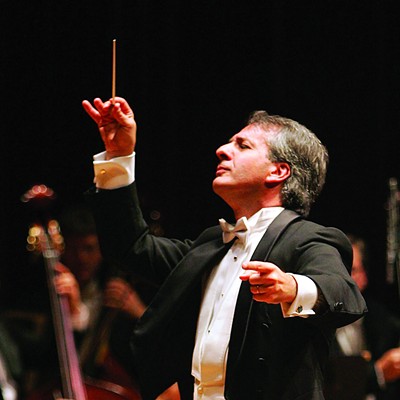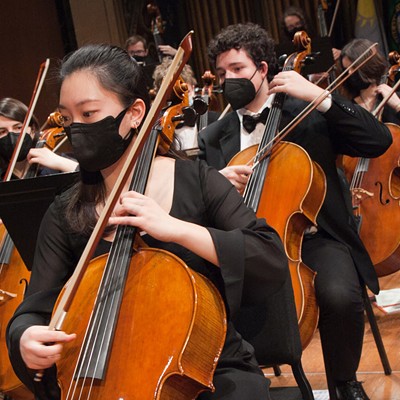There's a scene in an episode of Seinfeld in which Jerry, cued by something Elaine says about the overture from Leoncavallo's Pagliacci (which they're waiting in line to see), bursts into a song-and-dance number from an old Warner Bros. cartoon. "On with the show, this is it!" When the studio applause dies down, Elaine turns to him and snipes, "You know, it's so sad -- all your knowledge of high culture comes from Bugs Bunny cartoons."
Not that there's anything wrong with that.
While I've harbored a passive appreciation for classical music and opera my whole life, I've never taken the time to learn the difference between Puccini and Prokofiev, Haydn and Handel. I've been moved -- extraordinarily so -- by classical music, but never so much so that I've sought it out.
So, how is it that I can hum nearly every note to Rossini's The Barber of Seville? Why am I so intimately familiar with Wagner? Why does Smetana's "Dance of the Comedians" sound so familiar?
Because of Bugs Bunny. Because my brother was obsessed with Looney Tunes cartoons -- from his early childhood all through college.
Because, just before I left home for college, I pinched his audiocassette copy of Bugs Bunny on Broadway -- the soundtrack to the 1990 hit Broadway musical in which a live symphony orchestra performs with projected cartoons -- and have been playing it in heavy rotation in my 1986 Corolla ever since. Thus, my familiarity with Wagner's vaunted Ring Cycle, a 16-hour opera in four parts that gets pieced apart and reassembled as a seven-minute love/hate sequence between Bugs Bunny and Elmer Fudd. It's why I know Franz von Suppe's Die schone Galathee -- because that's the music playing in the background when Bugs plays his final prank on his "big fat opera singer" nemesis in Long-Haired Hare.
I warned George Daugherty about all of this -- that I knew next to nothing about classical music, and what I did know I learned from Bugs Bunny -- when we spoke on the telephone last week.
"Then you're the perfect person to do this interview," said Daugherty, the 52-year-old conductor who created Bugs Bunny on Broadway in 1990 and will tease it out of the Spokane Symphony this weekend.
Daugherty was in his mid-30s and well on his way to a promising career in "serious" classical music -- conducting for ballet companies in the United States and Europe -- when he visited some animator friends of his and rediscovered the Warner Bros. cartoons of his childhood. "Suddenly, I was seeing What's Opera, Doc? and The Rabbit of Seville, and all these masterpieces for the first time since childhood," he says. "But now as an adult conductor and musician, I realized that they had been created by some formidable geniuses. And for some inexplicable reason -- some people actually called it 'insane' -- I wanted to perform them. Live. In front of an audience."
In 1990, Daugherty opened Bugs Bunny on Broadway at New York's Gershwin Theater. There were the finely dressed denizens of the Theater District, and there on the silver screen were Bugs and Elmer and Wile E. Coyote -- voices and sound effects provided by Warner Bros.' original audio tracks, swelling scores provided by the symphony in the pit below. The production sold out its extended run.
This isn't as absurd as it sounds, this tuxedo-ification of talking bunnies. Daugherty says that unlike today's cartoon-makers -- or even contemporaries like Walt Disney and Max Fleischer -- Warner Bros. put a special emphasis on music. Not only did the scores to Looney Tunes and Merrie Melodies nod to and occasionally borrow from great classical works, but they occasionally made them centerpieces around which to build animation that fit them. "What's Opera, Doc?, Baton Bunny -- the classical music theme is actually the theme of the cartoon itself," says Daugherty. "But they loved to also stick it in to cartoons that had nothing to do with classical music. [Like Bedrich] Smetana's 'Dance of the Comedians.' Everyone in the world mostly knows it as the roadrunner's theme."
The masterminds behind the cartoon compositions were Carl Stalling and, later, Milt Franklyn, who conducted the studio's own symphony orchestra. The musicians spent each day recording scores for films like Casablanca and The Maltese Falcon and then squeezed in 30 or 40 minutes at the end of the day to lay down a cartoon soundtrack before heading to their night gigs with the Los Angeles Philharmonic.
"They didn't even schedule them as recording sessions," Daugherty says. "When you listen, there's a sound of daring, abject terror ... an incredible spontaneity to the original performances."
That's why, he says, he never gets stressed out if the orchestras he works with are on the edges of their seats. "That's where they should be."
Daugherty will have only rehearsed the show twice with the Spokane Symphony before they take the stage on Saturday night, although he brings a number of experienced guests to play the trickier parts (difficult piano passages, the slide guitar, wacky percussion instruments). The musicians, all in headphones, will face away from the screen and toward Daugherty, who stands at absolutely rapt attention before the screen. A host of monitors feeds him cues and timing information to ensure that the ensemble performance is synched exactly to the animated action on-screen, as they play the original scores note for note.
All the while, Carl Stalling is throwing little surprises in their tracks. "He did the unexpected. When the coyote falls off the side of the cliff, the whole orchestra is going deedle deedle deedle all the way down. Then, right when you expect a crash at the bottom, there'll just be a bass flute going doo-DOO."
The Symphony musicians will have to play difficult compositions in sync with the relentlessly manic rhythm of the cartoons, and in a style they're not used to. "The bass clarinet gets a real workout in this orchestra," Daugherty says. Moreover, they have to perform one piece after another -- a challenge never faced by the original Warner Bros. orchestra, which would rehearse one segment of a cartoon, record it, move on to the next, record it, finish the cartoon and head home for the day. "It's really harder on these orchestras."
The symphony will reel off about 10 original cartoons, resting during one or two to let the audience hear the original score with the animation. They'll also throw in a short tribute to animator (and Spokane native) Chuck Jones, as well as a piece called "The History of Warner Bros. Animation in Four and a Half Minutes."
This is the way Warner Bros.' cartoons were meant to be seen, Daugherty says -- on the big screen, in a room full of people. "The music is bigger than life, because there's a live symphony orchestra playing it. People never look at animation the same way again."
Or at least classical music fans will never look at animation the same way again. I suspect longtime Warner Bros. cartoons freaks like me will never look at classical music the same way again.




















